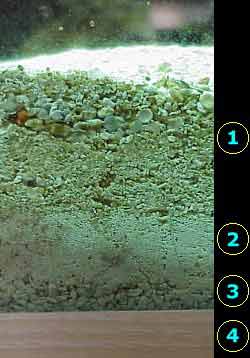
Example of Live Sand Layers in my Tank
Picture taken March 1999 This is a picture taken in March 1999 of my sand bed as it is against the glass. This picture was taken when the sand bed was only about 2 months old. You can already see several small worms against the glass and you can see tracks of other worms. The thickness of my sandbed ranges from 2 to 3 inches. Sometimes it peaks to 5 to 6 inches as the critters in the tank move it about. In the picture to the left you can see three bands of sand. These bands don't mean much, you can just see the layers of sand I added. 1 - The top layer is Fiji Live sand. As pictured it is about 1 1/4 inch deep. This layer is developing into two layers. A fine layer on the bottom and a larger layer on top. 2 - This is oolitic sand from Caribsea. This was dry sand, not live. It will turn live over time and has already started. I find most worms say within this band of sand. 3 - Crushed Coral sand. This was also dry sand from a bag. I had a few extra bags when I setup my 55g tank, and used it here. This layer is not needed. I would have just used a thicker oolitic layer. 4 - This is not a sand layer silly. This the the base of the tank. Someone actually asked what kind of sand this was. A sand bed is in a reef tank to perform a function. It is not just because it looks nice. The sand bed has to process detritus, uneaten food and dissolved organic materials. This is done by the infauna living in the substrate (sand) - such as worms, crustaceans, protozoa, and bacteria.Bacteria is important because it is part of the biological filter in the aquarium. It allows the export of nitrogenous waste like ammonia , as nitrogen gas. This neat trick can only be done as the bacteria grows. Many infaunal animals eat bacteria covered sediment as food. The clean sediment is passed as waste and this creates new space for more bacteria which aids in nitrogen production. In our tanks polychaete worms are the most visible and numerous infauna in our sand beds. Yes, even the bristle worms are important. They are excellent scavengers. A secondary role of the infaunal polychaetes are to create micro-plankton such as eggs, sperm, and larvae. Remember that everything (like food) that you introduce into the aquarium stays in the tank unless it can be exported. Between the fish and corals kept in a reef tank, a lot of food will be introduced. A sand bed will help to process this material being introduced. The keys roles of the sediment infauna are to 1) prevent accumulation of organic material in the sediment, 2) feed filter-feeding critters in the tank with the larvae they produce, 3) maintain the biological filter within the tank. The sediment size used within the tank is very important. It should not be all one size. Particles within the sand bed should range from coarse sand (2.0+ mm) such as my Fiji Live sand and crushed coral sand to fine sand (0.06 mm) like oolitic sand. The majority of the live sand in my tank are very fine oolitic sand. It is recommended that at least 60% of your sand bed be course to find sand. In my tanks I think I'm closer to 80%. Many people think they can start a sand bed with just dead sand and think that critters from the live rock will migrate to the sand. Some do, but you will lack the diversity needed to have a healthy sand bed. You need live sand to get the appropriate critters. I recommend you get live sand from several vendors over different times of year to maximize your diversity. My live sand bed is from 4 vendors, over several years, plus several detritivore kits have been added. I'll continue to get small batches of live sand in the future to increase sand bed depth and maximize diversity. It can take a sandbed about 18 months to become fully mature -- developing a good sand bed is not done over the weekend and it is not a kit you just add. Lastly, stay away from animals that eat critters within the sandbed such as sand sifting gobies (like Sleeper gobies) and burrowing sea stars. These animals are eating the infaunal critters in the sand. Animals like burrowing sea cucumbers eat bacteria off the sediment, these are fine. Above includes information from Dr. Ronald L. Shimek and Rob Toonen. |
